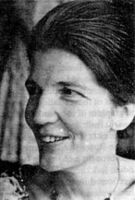Valentina Stache-Rosen
Stache-Rosen, V.
| PersonType | Category:Translators |
|---|---|
| FirstName / namefirst | Valentina |
| LastName / namelast | Stache-Rosen |
| MainNamePhon | Valentina Stache-Rosen |
| SortName | Stache-Rosen, Valentina |
| bio | Mrs. Stache was no professional Indologist, although her earlier studies in Buddhist literature went in this direction. She continued to work in the field of Indoiogy after her marriage, and so much so that she was well known among the professionals. During the long years of her stay in India she became interested in Indian folk art, and she was one of the first Germans to research on it.
Valentina Rosen was born on 28.4.1925 in Copenhagen, where her father worked at the time in the German Embassy. She came from a family of orientalists which had served as diplomats with the Prussian, later the German Foreign Office for three generations, mostly in oriental countries. It was therefore quite natural for her to take up oriental studies. Impressed by a stay of 4 years in Peking, she chose Chinese and Sanskrit as subjects of study at Goettingen University, to which she added Archeology during a 2 year stay in London as a student at the Institute of Oriental Studies. Returning to Goettingen, she was advised by E. Waldschmidt, then head of the Indological Institute there, to concentrate on Indian studies and to join the group of students which fervently worked with him to reconstruct, edit, and translate those fragmentary, mostly Buddhist Sanskrit manuscripts which several expeditions to East Turkestan had discovered in ruined monasteries, mainly in the Turfan oasis, and which had been deposited at the Berlin Academy of Sciences at the time. She worked for her doctorate on one of these manuscripts, a text on the Buddhist monks discipline, and got the Ph.D. from Goettingen University in 1954 for the thesis Der Vinayavibhanga zum Bhikṣhupratimokṣha der Sarvastivadins; Sanskritfragmente nebst einer Analyse der chinesischen Uebersetzung (Sanskrit fragments together with an analysis of their Chinese translation), published by the Berlin Academy of Sciences as No. II of the series "Sanskrittexte aus den Turfanfunden ", 1959. A second publication followed in the same field of studies as No. IX in the series "Sanskrittexte aus den Turfanfuden" of the Berlin Academy, Dus Sangitiszma und sein Kommelltar Sangitiparyaya, in 2 vols., Berlin 1968, an edition and translation to which she dedicated 4 years of work. A further publication concerning a text oe [sic] the Buddhist monks' discipline has been prepared in later years, Dlls Upaliparipricchasutra; . . . As a by-product of these later studies, she wrote a comparative analysis of the numerous biographies of the monk Gunavarman in the Chinese Tripitaka, Guṇavarman, in Vol. X/1 of the Bulletin of Tibetology, Gangtok 1973. Studying in India in 1955-57 with a scholarship from the Indian Government, and returning to India in 1971 and living in Bangalore till 1980, Valentina Stache-Rosen became more and more interested in Indian history of culture, folklore, and folk art. She was fascinated by the colourful religious ceremonies of Kerala, by the unique cultural heritage of South-Kanara, by the different styles and literary versions of the South Indian shadow-theatre, and by many a subject on which one can correctly work only when one has the possibility to stay in the country for a long time and is able to travel freely. Being an excellent photographer and a well informed student of Indian literature, she brought together a good deal of documentation in pictures and texts. Preliminary papers have been published occasionally, in Germany and in India. Among them are Schattenspiele und Bildervorfuehrungen in Jndien (On the shadow plays and picture shows in India), ZDMG 1975, English version in Quarterly of the Mythic Society of Bangalore, vol. 56, 3/4; On the Shadow Theatre in India, in 'German Scholars on India', vol. II, New Delhi 1976; Gandabherunda, Zur Tradition des doppelkoepfigen Vogels in Suedindien (On the tradition of the double-headed bird in South India), in 'Beitraege zur Indienfor-schung,' Veroeffentlichungen des Museums fuer Indische Kunst Berlin, Band 4, Berlin 1977, English version in the Quarterly of the Mythic Society Bangalore, Vol. 67/1976, Bangalore 1978; Survival of some ancient forms of audio-visual education in present-day India in 'Studies in Indo-Asian Art and Culture' V, Acharya Raghn Vira Commemoration Volume, Delhi 1977; A note on the so-called Yogini Temple of Coimbatore, in Quarterly of the Mythic Society, Vol. 69/1978, Bangalore 1979; a.o. She prepared an exhibition of her photographs of Bhutas and Teyyams and collected extensive information on the spirit worship and the ntual [sic] dances of South-Kanara and Kerala for the exhibition-catalogue and for later work. This documentary exhibition was shown in a number of towns in India and has toured German towns as well. As she had lived not only in India for a long time, but for several years each also in China, Indonesia, Pakistan, and Iran, learning the languages of the countries, travelling extensively and collecting materials, especially i[n] the field of folk-culture, she had great plans of studies and publications for a time that she would retire with her husband to a quiet place in Southern Germany. An adverse fate ended all her expectations, shortly after her return to Europe. Valentina Stache-Rosen died on 20.10.1980 in Munich from cancer which she bad unknowingly carried home with her. (Appendix II in German Indologists, 1981) |
| IsInGyatsa | No |
| Other wikis |
If the page does not yet exist on the remote wiki, you can paste the tag |

